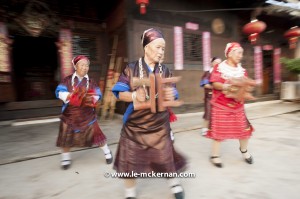Travel Blog – Guizhou Province, China
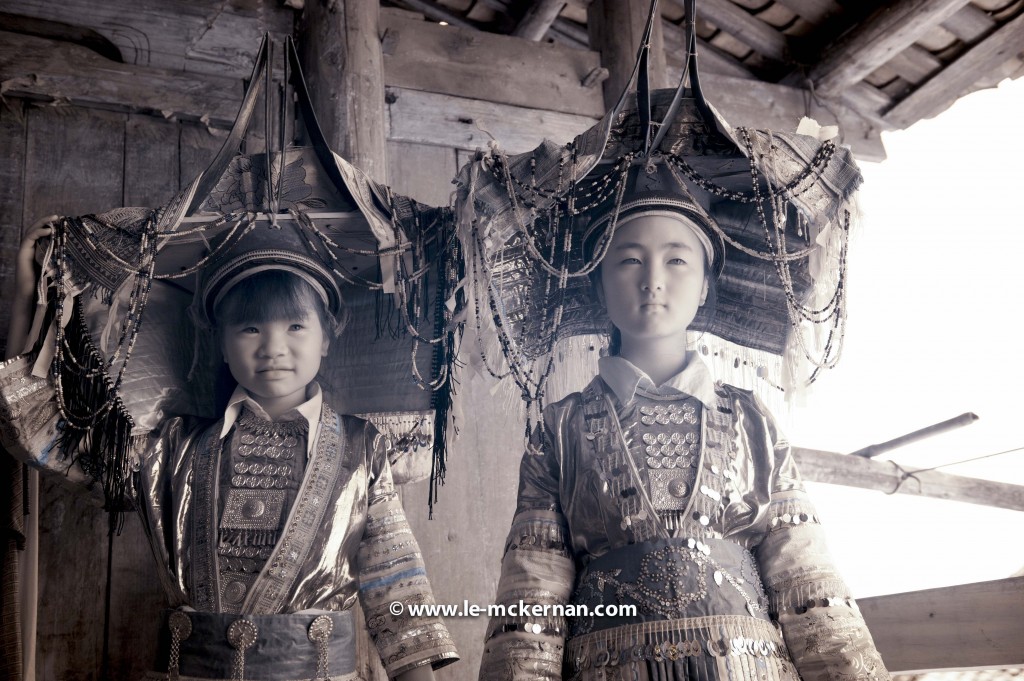
August 2012

Equipped with news footage about the torrential rain in China and with an email from our group leader to bring along proper rain gear, I had visions of mud, mud, more mud, grey skies, and lots of rain — in other words, I had to pack for a typical British summer day! To this end, I’d packed my green Yorkshire wellies for the expected deluge.
Fortunately, the worst of the rain had passed by the time we arrived and the most we got was a little drizzle every now and then. But unfortunately, there were landslides everywhere and this impacted our itinerary in a BIG way. As such, we missed a major festival as the roads were impassable. In addition, another festival set along the riverbank (and in the river itself!) was cancelled due to inclement weather. Furthermore, a village that is only accessible via a natural limestone cave tunnel was ruled too dangerous for us to reach because in the narrowest part of the cave, the water was chest-high and fast moving (more importantly, our camera gear would have gotten wet!).
With our plans in disarray, we had to rely on our local fixers’ extensive knowledge and networks (as well as a good dosage of serendipity). For the most part, this was successful. The most memorable of these encounters was an evening funeral at a neighbouring village. We honestly did not know what to expect, but, we knew that this invitation was too incredible to pass up. So, we hopped on the bus and hit the muddy and bumpy mountainous roads with vertiginous drops (fortunately, it was too dark to see the drops) and hairpin turns. The drive to the village took much longer than we expected (due to the poor road condition). Once we arrived in the village, we knew immediately that we were going to have an unforgettable experience. The first clue was the hauntingly beautiful sounds coming from the Lusheng pipes (made from bamboo). The second clue was the huge turnout — there must have hundreds of people from the village (and neighbouring villages). And, the third clue was the start of the fireworks. We arrived just in time — the funeral festivities had just begun.
It was a funeral unlike anything that I have experienced before. In the main house, the mood was somber. But outside the house, there was music, dancing, and general merriment. This continued throughout the night — and even while the shaman performed his rituals.
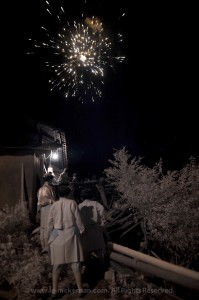

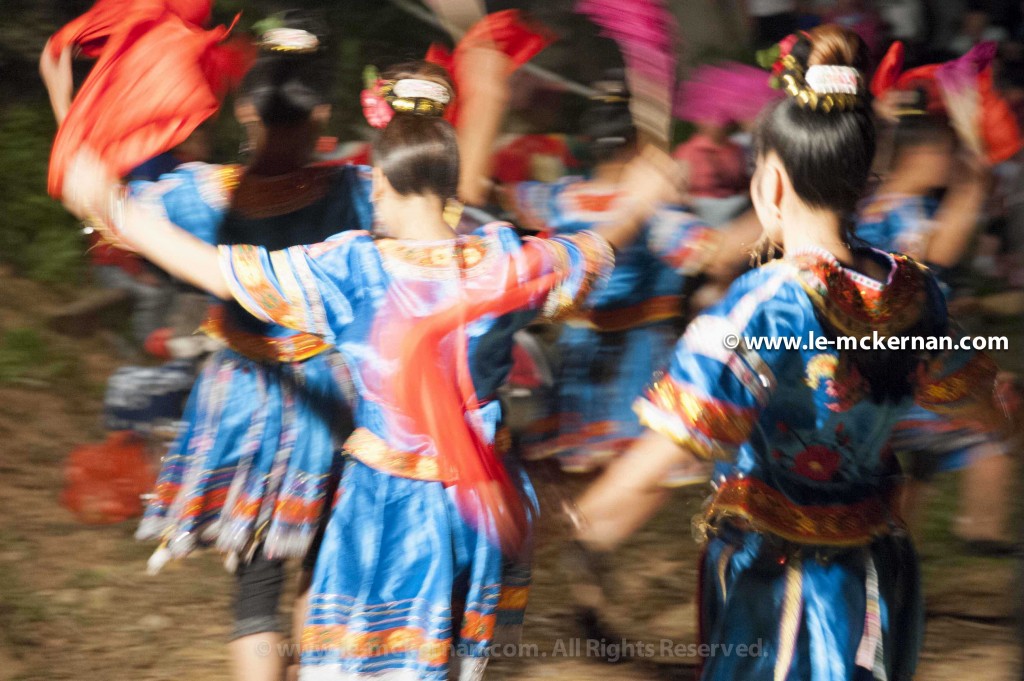
The funeral was for Mr. Liu Wen Shu, a 66 year old ex school teacher at Wuyao Village. The Miaos believe in burying their dead only on auspicious dates and as such, Mr. Liu’s funeral was delayed until this evening. As such, the body was kept in a refrigerated casket in the corner of the room. In the other corner, the family lit candles and provided offerings to the spirits. The immediate family sat by the casket while the shaman and his assistant conduct the funeral ceremony.

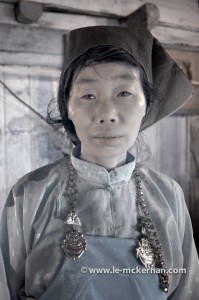
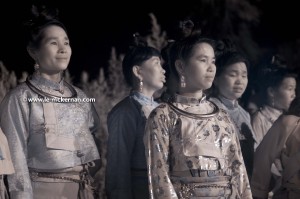
Although we did not know the deceased or his family, as foreign visitors, we were greeted warmly and treated as honoured guests. At around 11:30 PM, we could see lightening in the near horizon and sensed that a nasty storm was brewing. Mindful of how bad the road was under good condition, we were keen to leave before it started to rain. Once the word got out that we were about to leave, the family invited us to stay on but we had to politely decline. The festivities were in full swing as we were leaving and my parting memory of this incredible night was the bull-fighting dance.
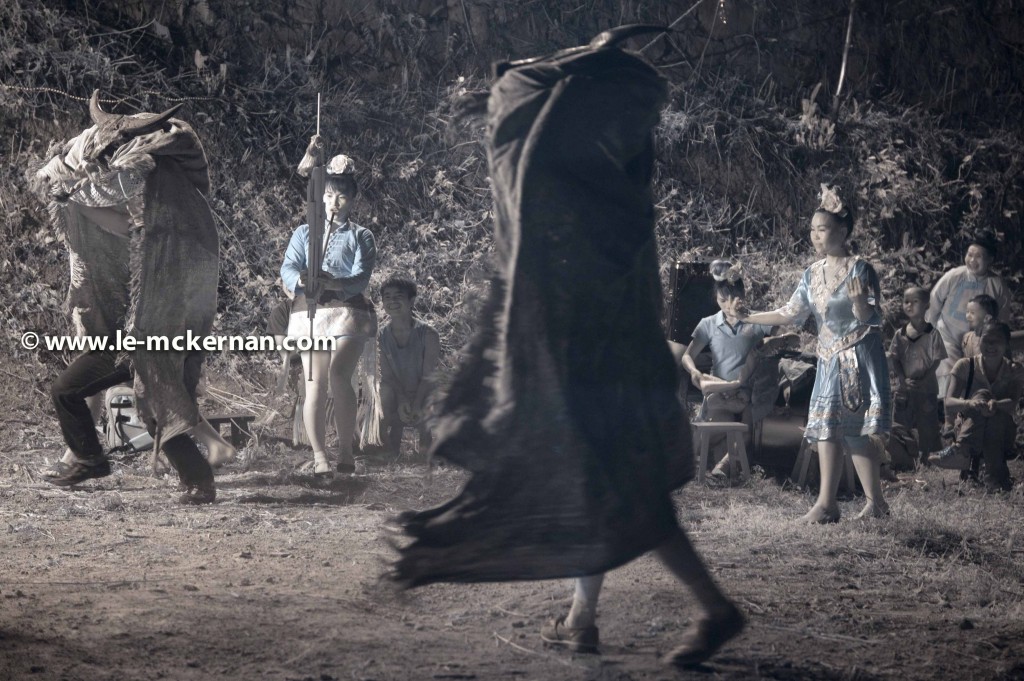
Mr. Lui’s funderal wasn’t the only funeral that we came across. Quite coincidently and accidentally, we stumbled upon another wake in a different village earlier in the day. The ceremony actually started the previous day but the celebration was still under way when we arrived. (We should have known that something was going on as we saw three men fast asleep on the road as we entered the village!) We were drawn to the event by the commotion of the women washing the dishes and preparing more food. Once there, the men seized upon us and bestowed tremendous hospitality. Although we politely declined the food and drinks (since we just had our lunch), the men were jovially persistent (as you can see from the below photographs).


The main goal of this trip was to explore and photograph the lesser-known festivals of the Miao (known more commonly as the Hmong) — one of province’s largest ethnic groups. Although we missed out on a few festivals on the original itinerary, the local guides helped find alternative festivals and events. The first was a harvest festival at Shuiguo village (Jiuqian township) whereby the shaman made a blessing for rain and good harvest by a pond. As part of this ritual, the locals provided food for the spirits (pig head, fish, fruit, and rice). In addition, a pig and some ducks were thrown into the pond and the local men waded into the water to catch the animals and bring them ashore. This symbolized reaping the fertility from the land and water. In addition, the local women performed a song to ward off evil spirits.
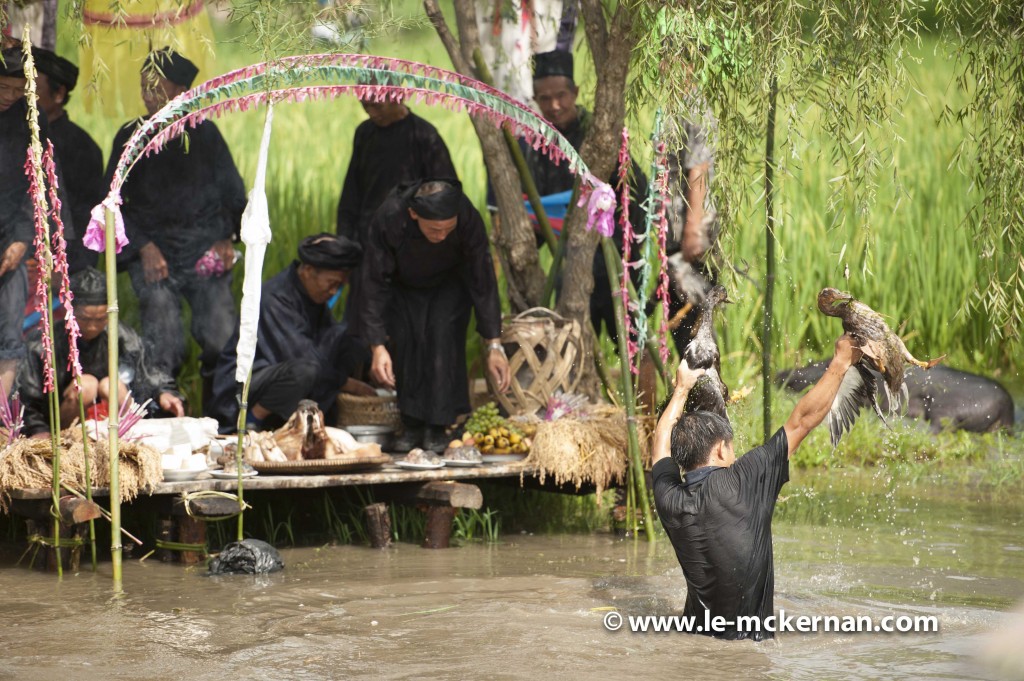
The next festival was held at the Huang Gang village. As we arrived before the festival started, we wandered around the small village. At the school, the children were in their festival fineries. They too were waiting for the festival to begin. But in the interim, they played. It was a joy to see kids being kids.

The first mark of the start was the sound of the Lushseng pipes. A procession including the shaman, his assistants, the villagers and the children followed. The last in the procession were the men carrying the sacrificial pig. Ontop of a raised platform in the middle of the village square, the shaman beat a drum while turning to face all four directions (north, west, south and east). Interspersed were songs and dances — some must have been either very bawdy or comical as the audience reacted to the lyrics with great laughter. At the end, the entire procession grabbed hands and formed circles and danced. Some in our group were caught up in the merriment and had to stop photographing and join in.

Video (23 secs) – link to Facebook
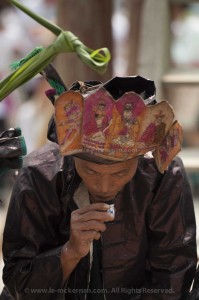
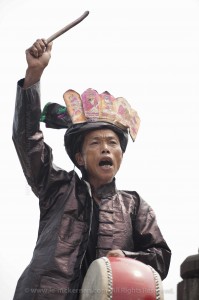


the poor pig gets it !!!
After this ceremony, there was a temporary break whereby the locals returned home for lunch. We took advantage of this lull to wander around the village and found the sacrificed pig roasting over an open fire. The local butcher then cleaned, gutted, and carved the pig. At one point, we saw one man blowing air directly in the intestines — we were later told that this is to move the contents of the intestine together so that it would be easier to remove! (For pictures and video on the pig sacrifice, please check out the food blog on Guizhou Province.)
After the long lunch break, the festival continued with a harvest/fertility ritual whereby a small group of teenagers waded into the village pond to catch the catfishes. The abundance of catfishes symbolized the upcoming harvest bounty. But, the in truth, it looked more like an opportunity for the villagers to have fun — the whole ritual turned into a massive mud fight!

The most surprising festival we visisted during our 2 weeks in Guizhou Province was the Climbing Mountain Festival at Linshan on Shixian Mountain. This festival was said to celebrate the day when Avolokitasvara Bodhisattva achieved enlightenment. But, it was a huge shock for us to see dog fighting and bull fighting featured at what was a Buddhist festival! Atop the mountain was a temple where some worshippers burned incense, but, the core of this festival appeared to be the fights (and the gambling.) Upon closer inspection, we noticed that there were very few Miao minorities at this festival — it seemed to have been usurped by other groups.
Fortunately, it was NOT a death contest — the first animal to back off from the fight automatically lost. Nonetheless it was uncomfortable to watch the dogs get bloodied. The bull fights were a little easier to watch as they were quicker to yield. One fight in particular lasted only 2 seconds as it was clear that one animal simply didn’t want to fight. Almost immediately, it turned away and the fight was declared over. However, in another case, there was a sustained fight and the two beasts were quite pugnacious! The fight actually spilled over to where the crowds were standing. Luckily, the locals knew to be nimble during the bull fights and thus got out of the way just in time. The keepers had great difficulties getting the animals back into the fighting pen again. It was interesting to observe the behaviour of one bull — it was angry and not cooperative at all, but, the moment one of the keepers grabbed control of it’s nosering, the bull immediately became docile.
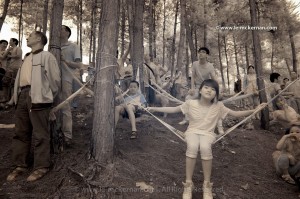

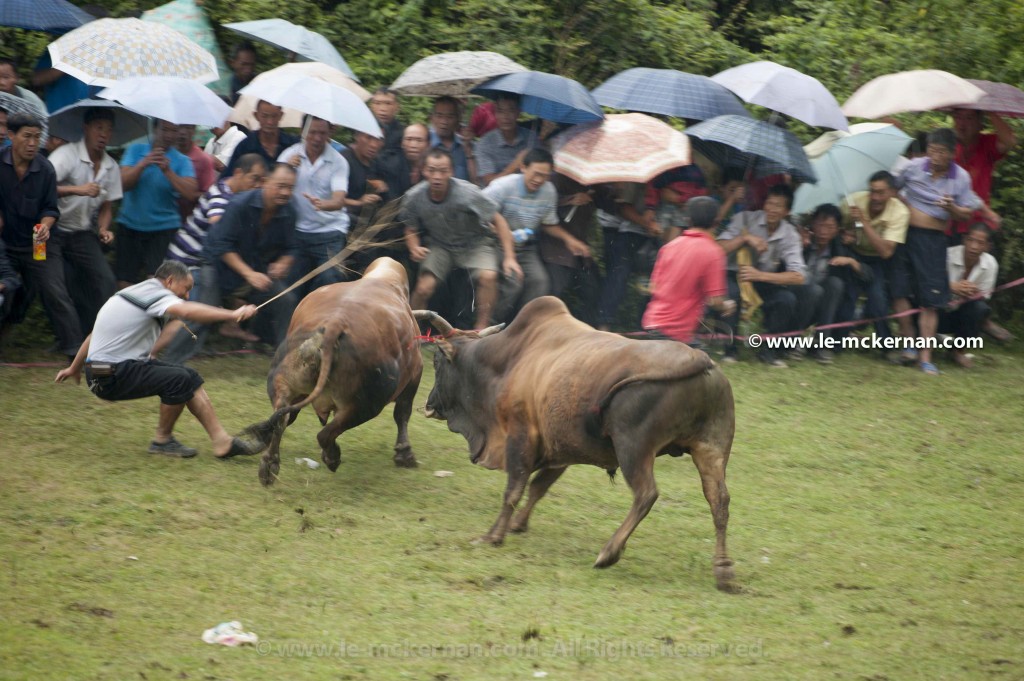
As an antidote to the blood sport, the next festival was more genteel. There was a Miao dancing competition and about 5 sub-tribes attended. The competing groups ran the full gamet from seasoned veterans to young kids. The commonality was that the women and girls were festooned with elaborate silver jewelery and colorful costumes.
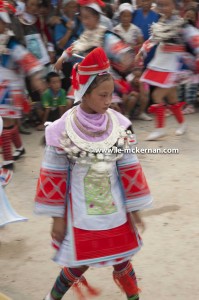

In between the various festivals, our guides helped organize home visits with different Miao tribes. In some cases, the Miao kindly donned their festival clothes and permitted us to photograph them. In addition, our local guides introduced us to some weavers and artisans in the region. One in particular was a master of the ‘cloth folding embroidery’ technique. Her festival coat took six years to complete as the technique is highly intricate. Her head piece was inspired by the long-horn headpiece but instead of using the traditional silver metal, she used only embroidered cloth to make this remarkable and highly unique hat! Some of our favorite photographs from these visits are:
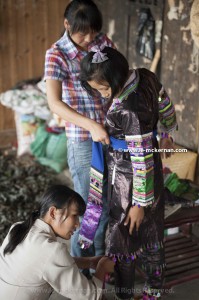
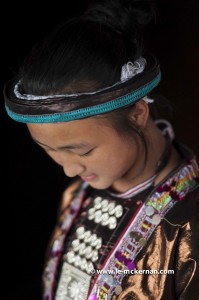
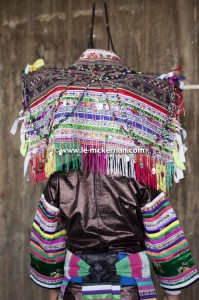
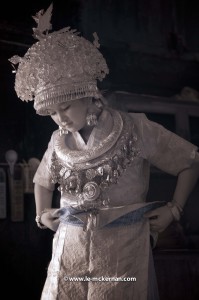
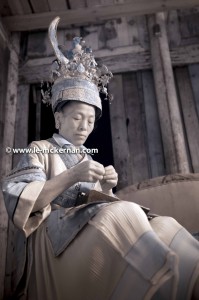
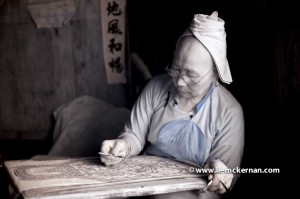

A few days later, we attended our very last festival of the trip. This was a major festival held in Kaihuai town in which the former governor of Guizhou Province attended. Given that he was a ‘big potato’, a pig was sacrificed in his honor. His attendance attracted more Miao sub-tribes and we were treated with AMAZING tribal costumes and dances. A big ‘plus’ was that we arrived early and were most fortunate to see the ladies ‘gear up’ for the festival.

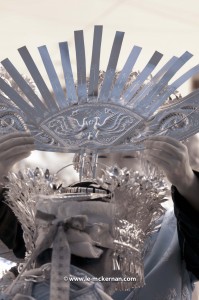
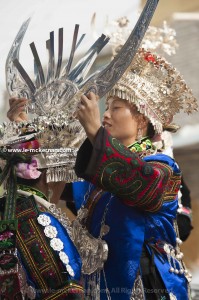
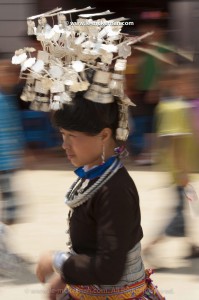
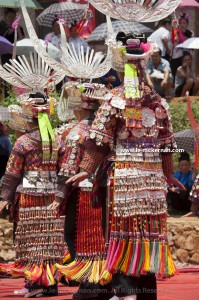
After the festival, there was an enormous traffic jam — the kind that only happened in Asia. Rather than sweat it out, we decided to enjoy cold beer in a nearby restaurant until the situation improved.
A quick word about the roads in Guizhou Province. Bruce and I actually joked that because of our horse riding experience, we knew how to land on our butt properly each time we flew into the air when going over a pot hole. On some roads, the condition was pitiful — in fact, one member of our group actually dislocated her shoulder when we went over a pot hole a little too quickly (she had to go to the hospital to reset her shoulder)! But, on the flip side of the equation, we saw miles and miles of newly paved roads and new highways. Construction in Guizhou Province was mind-blowing — it just went on and on and on and on — to the point that some roads actually lead to nowhere. We’ve been on major paved roads that suddenly stopped — the road building was still in progress! Furthermore, we have been on new highways whereby even the petrol stations and rest stops hadn’t been staffed yet.
Technically speaking, our travels around Guizhou Province covered only a small area. But, there were days whereby we spent long hours getting to places that were technically not that far away (i.e. as the crow flies). Guizhou Province is 80% mountainous and as such, we were on country roads more often than not. This meant dirt roads, rock slides, and narrow passes. When the mountain road network is modernized, this will be a double-edged sword for the Miao hill tribes. On the one hand, it will make their life easier; but on the other hand, the local traditions and characteristics are at risk of getting muddled as they become less isolated. As such, we have decided to visit this region again in the near future before modernization destroys what makes the hill tribes and their festivals so special.
For more photographs from this trip, please click on this link.
+ + + +
We traveled on a private tour organized by Nevada Wier (www.nevadawier.com) in conjunction with Lin Xue Biao (owner of Global Expeditions at glbexpd@public.cd.sc.cn) and Lee Maoqing, an expert in the region.

